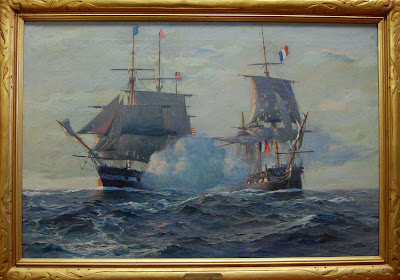Artifact Spotlight: Powder Measures
---Joshua Howard, Curatorial Volunteer
Powder measures such as the two in the museum’s collection were standard issue to vessels in the Age of Sail. Explosive black powder was used to propel a projectile towards a target. The powder was pre-prepared in a canvas sack and loaded down the barrel of the gun before the shot. The measures, like a ship's powder magazine, were made of copper to prevent sparks from accidentally igniting the powder. A ship was provided with several of these measures based on the number of guns the vessel carried. According to Instructions in Relation to the Preparation of Vessels of War for Battle, published by Order of the Navy Department in 1852, "Powder measures for filling cartridges will be made at the Navy Yard, Washington, and distributed as they may be required for the use of vessels and shore magazines. They will be marked with the weight of powder which they will contain, and will be cylindrical, and of the following interior diameters, viz: For 64 pdr. shot guns...7 inches/For 10 inch shell guns with 42pdr. cylindrical chambers, 6 inches/For 8 inch shell guns with 32 pdr. cylindrical chambers, 5.5 inches/For all 32 pounder shot guns, ...5.5 inches. These diameters are the same as are prescribed for the cartridges of the respective guns, and will consequently always form standard gauges with which the cartridge formers may be compared and verified."
A ship would carry at least one measure for every type of large gun that the vessel contained in order to properly measure out the right amount of powder it would need to fire. Properly loading a cannon or deck gun with powder was essential, as too little could cause the weapon to misfire and too much could cause the gun to explode in place from the strain. The measure marked for 1 pound was likely used to prepare charges for a 12 pdr. Dahlgren boat howitzer, while the measure marked 12.5 pounds prepared the 12.5 lb. charge required for a X-inch smoothbore Dahlgren gun which fired a 124 lb. solid shot or a 101.5 lb exploding shell.
 |
| 12.5 lb. powder measure |
This week’s artifact takes us back to the Age of Sail when loading a naval gun was a much more labor intensive system than it is today. Today’s post spotlights a pair of copper powder measuring cups, a vital component to a vessel's ability to properly arm their guns for firing. One of the measures is inscribed, “I. LB” and the other is inscribed, “12.50 LBS., ORD., 1857” along with an anchor stamped into the metal.
Powder measures such as the two in the museum’s collection were standard issue to vessels in the Age of Sail. Explosive black powder was used to propel a projectile towards a target. The powder was pre-prepared in a canvas sack and loaded down the barrel of the gun before the shot. The measures, like a ship's powder magazine, were made of copper to prevent sparks from accidentally igniting the powder. A ship was provided with several of these measures based on the number of guns the vessel carried. According to Instructions in Relation to the Preparation of Vessels of War for Battle, published by Order of the Navy Department in 1852, "Powder measures for filling cartridges will be made at the Navy Yard, Washington, and distributed as they may be required for the use of vessels and shore magazines. They will be marked with the weight of powder which they will contain, and will be cylindrical, and of the following interior diameters, viz: For 64 pdr. shot guns...7 inches/For 10 inch shell guns with 42pdr. cylindrical chambers, 6 inches/For 8 inch shell guns with 32 pdr. cylindrical chambers, 5.5 inches/For all 32 pounder shot guns, ...5.5 inches. These diameters are the same as are prescribed for the cartridges of the respective guns, and will consequently always form standard gauges with which the cartridge formers may be compared and verified."
 |
| 1 lb. powder measure |
A ship would carry at least one measure for every type of large gun that the vessel contained in order to properly measure out the right amount of powder it would need to fire. Properly loading a cannon or deck gun with powder was essential, as too little could cause the weapon to misfire and too much could cause the gun to explode in place from the strain. The measure marked for 1 pound was likely used to prepare charges for a 12 pdr. Dahlgren boat howitzer, while the measure marked 12.5 pounds prepared the 12.5 lb. charge required for a X-inch smoothbore Dahlgren gun which fired a 124 lb. solid shot or a 101.5 lb exploding shell.
The copper measuring cups were donated to the War College in 1997 by Captain Maddox N. P. Hinkamp of Jamestown, RI. The donor indicated that the measures belonged to one of his late wife’s grandfathers, Commodore James B. Parker or Captain Charles E. Colahan, who were both distinguished naval officers.
Images Courtesy of Naval War College Museum and Naval History and Heritage Command



Comments
Post a Comment